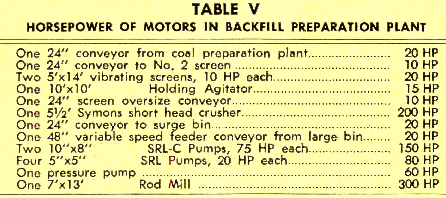Table of Contents
Backfill Preparation Plant: Mine roof support problems were a major concern that necessitated the use of backfill to supplement conventional means of support. Roof supports account for at least one-half the cost of mining at Sunnyside. Roof bolts and round timber are used for roof support, plus yieldable steel arches for severe ground, air courses, mine haulage ways and mine openings. On a typical day Sunnyside installs 1000 roof bolts, 200 props, and 20 steel arches.
Backfilling is an important aid in reducing roof failure and violent bursting of mine pillars. From 1500
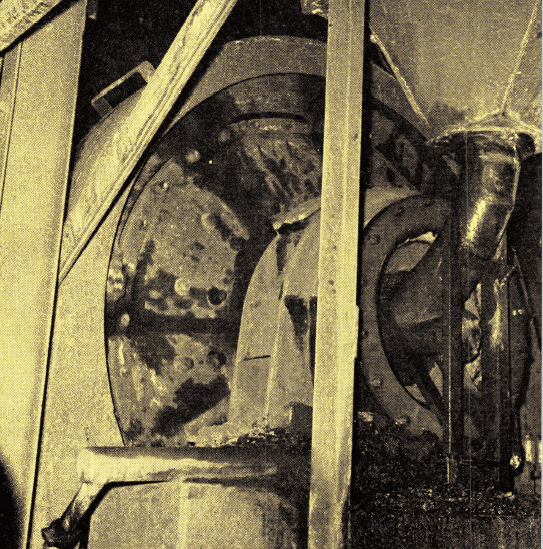
Feed to 7’x 13′ Center Peripheral Discharge Rod Mill is a blend of —½”+3/8″ and —3/8″+1/8″ products from the screens in closed circuit with the rod mill. Balanced blend of the two feed sizes is controlled by an AccuRay gamma sensing device installed on the rod mill pump discharge line.

to 1800 tons per day of 6″x 0″ coal washing plant refuse are ground and sized to all minus 1/8 ” and pumped into the mine to fill abandoned workings adjacent to main haulageways and air courses.
Screening and Grinding Section
Coal refuse from the washing plant is transported on a 24″ conveyor to the backfill plant where it is split to two 5’x 14′ triple deck vibrating screens. These screens are unique in that each deck has three different size screens on each deck and three different products are taken from the lower deck by three chutes. The two upper decks provide protection to minimize wear on the lower deck. All screening is done wet. The first one third section of the lower deck is equipped with a 1/8″ wedge bar screen and the —1/8″ product goes directly to a 10′ dia. x 10′ deep Holding Agitator equipped with a turbine type propeller and 15 HP motor. The agitator pulp is then pumped by a 10″x 8″ SRL-C Rubber Lined Pump to a 21 ‘-6″ dia. x 20′ deep Backfill Blending Tank.
The second one-third section of the lower screen deck has 3/8″x1″ slot screen cloth; the — 3/8″ product goes directly to a 7′ dia. x 13′ long Center Peripheral Discharge Rod Mill which is fed from both ends. The rod mill uses 3″ dia. rods. Discharge from the rod mill goes to a sump and a 10″ x 8″ SRL-C Rubber Lined Sand Pump in closed circuit with the 5’x14′ screens. The Center Peripheral Rod Mill was specified to produce a minimum of slimes.
The third one-third section of the lower screen deck has ½”x2″ slot screen cloth and this undersize product can either be sent to the Rod Mill if there is insufficient 3/8″ material for rod mill feed or it can be blended with the screen oversize. An AccuRay Density Control Meter on the Rod Mill Pump discharge activates two 24″x48″ variable speed vibrating feeders which feeds the minus ½” material from the third section of screens to maintain the Rod Mill working at capacity.
The screen oversize from all three decks on both screens discharges onto a 24″ belt conveyor feeding a 5½’ Symons Short Head Cone Crusher. Discharge from
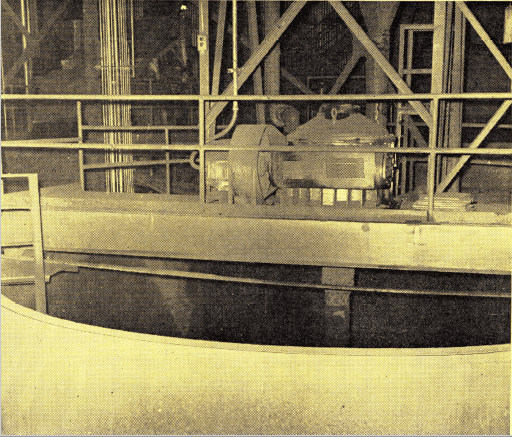
Mine backfill blending agitator is 21′-6″ dia. x 20′ deep. Drive is by No. 18 Agitator Drive and 60 HP motor. Agitator has 84″ diameter Turbine Type Propeller which effectively suspends the —1/8″ backfill material in a pulp of 42-45% solids.
the Symons Crusher is taken by a 24″ belt conveyor to a 20′ dia. x 54′ high surge bin. Discharge from surge bin is by variable speed 48″ belt feed conveyor to a 24″ belt conveyor in closed circuit with the 5’x14′ screens. The 48″ variable speed belt feed conveyor is activated by the AccuRay Density Control Meter on the Rod Mill Pump discharge to keep a constant load in the screening-grinding section. Enough rock is accumulated in the 20′ dia. x 54′ high surge bin to run the backfill plant during the time the washing plant is shut down on graveyard shift.
Blending and Pumping Section
The —1/8″ ground backfill material from the 10′ dia. x 10′ deep Holding Agitator plus the slime tailings from the coal washing plant flotation section are pumped to the 21′-6″ dia. x 20′ deep Blending Agitator. This agitator has an 84″ dia. Alloy Steel Turbine Type Propeller, powered by a No. 18 Agitator Reducer Drive equipped with a 60 HP motor. Density in blending agitator is controlled by an AccuRay Density Control Meter on a 1½” pump line pumping from the bottom to top of blending agitator to maintain the solids between 42% and 45%.
There are three 4″ backfill lines from the blending tank to the mines. Two lines are 4,000 feet long and one is 14,000 feet long. The two 4,000 foot long 4″ backfill lines each have two 5″x 5″ SRL Rubber Lined Pumps connected in series. Each pump has a 20 HP motor and pump speed is 925 RPM.
The one 14,000 foot long 4″ backfill line has one Wilson-Snyder Double Stroke Piston Pressure Pump. Pump has a 60 HP slip-ring motor, geared down by belt drive and gear reduction to 52 strokes per minute on each side.
Initially the backfill preparation plant was designed to deslime the minus 1/8″ material by cycloning before pumping to the mine. Experience showed the slime
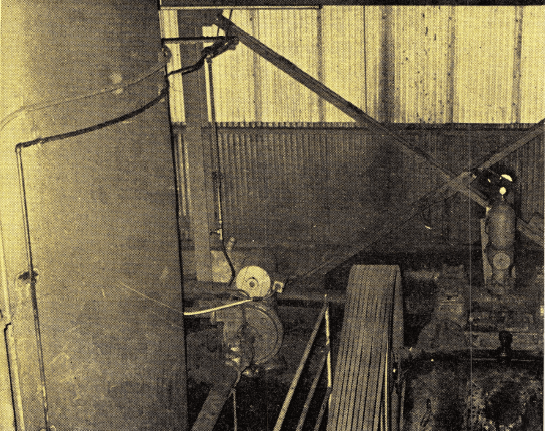
Blended backfill material is pumped to the mines. There are three 4″ lines to the mines, one 14,000′ and two 4,000′. Two-stage pumping is used. Pumps are 5×5 SRL Pumps with 20 HP motors. Part life is from 400-450 hours service on the —1/8″ material.
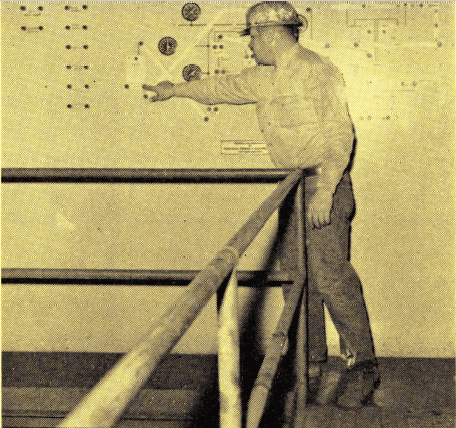
The modern design of plant and equipment is typified by the central control panels. A colored flow-diagram is used with the AccuRay Density Control Meter Dials.
content had no detrimental effects underground and that the pumping characteristics were improved by not desliming.
Controls
A panel board with all controls is located in the upper section of the backfill plant where one man can watch all equipment. A colored flow diagram is on the panel board with AccuRay Density Control Meter dials. Both automatic and hand control are used on Rod Mill Feed but AccuRay Density Control Meter on blending tank has an automatic control only.
Backfilling Underground
Backfilling has been used primarily for three types of operations:
- The filling of obsolete entries and worked out pillar areas to consolidate support and stabilize ground movement in regions of permanence such as main haulageways and air courses. This has been the largest consumer of fill thus far.
- The use of fill over the yieldable arches and
- The use of fill plugs or seals to isolate worked out or possible fire areas. In particular instances all three of these benefits have been gained from a sustained filling in a single area.
Slopes destined for backfilling are first dammed off at the lower point to which the fill is to be made. Timber dams are built at this location and in the pertinent cross-cuts. Timber dams are covered with burlap which retains the backfill solids above the dam, but lets the water through. Backfill is pumped to the top of the slope and flows by gravity to the dams. The slopes are filled with backfill rock from the floor to the roof, thus making a solid and compact fill. Water drains through the burlap and to the main sumps for reuse.
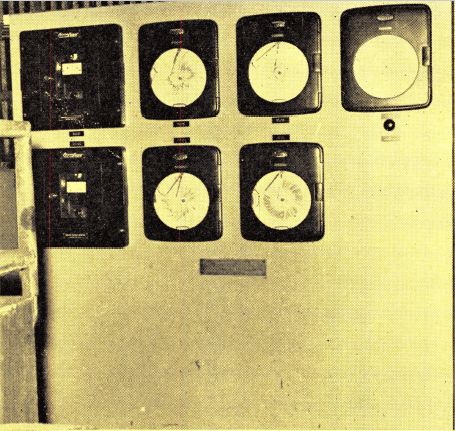
Recording type gauges are used to assure dependable blends of density and size material which assures proper material for mine backfill.
Haulageways and air courses supported by yieldable arches on 3-foot centers are lagged over with landing mats, or other appropriate mats, and covered with burlap, scrap timber, coke breeze and backfilled. In filling caved areas no attempt is made to erect dams between the fill and the caves as little loss of backfill material is experienced by allowing it to back up against the caved material.
The application of yieldable arches and backfilling has been instrumental in attaining great improvement in safety, prolonging the life of a valuable coal property by many years and has made possible the mining of coal at reasonable cost under severe mining conditions.
